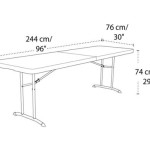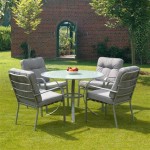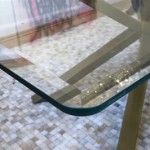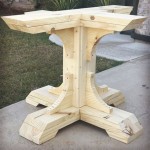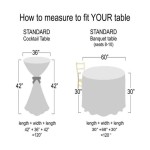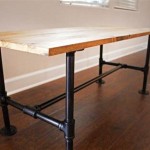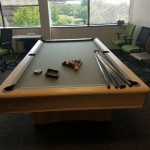Exploring the Functionality and Style of Tables with Ottomans Underneath
The concept of multi-functional furniture has gained significant traction in contemporary interior design. This trend prioritizes efficient use of space and adaptability to various lifestyle needs. One manifestation of this trend is the table with ottomans underneath. This furniture arrangement combines the practicality of a table with the comfort and additional seating offered by ottomans, all while maintaining a compact footprint. Understanding the nuances of this design requires an examination of its benefits, variations, and considerations for optimal integration into a living space.
Tables with ottomans underneath are not a new invention, but their popularity has surged due to the growing demand for furniture that maximizes space utilization, especially in smaller homes and apartments. The design typically involves a table, often square or rectangular, accompanied by two or more ottomans designed to fit neatly underneath. These ottomans can serve as extra seating for guests, footrests for relaxation, or even small side tables when needed. When not in use, they remain tucked away, freeing up valuable floor space.
Space Optimization and Versatility
The primary advantage of a table with ottomans underneath lies in its exceptional space-saving capabilities. In limited square footage environments, every inch of space counts. Separately purchasing a table and seating can quickly consume a significant portion of the room. This combined design consolidates these elements, creating a functional centerpiece without sacrificing precious space. The ottomans, neatly tucked away beneath the table when not in use, prevent unnecessary clutter and contribute to a cleaner, more organized appearance. This is particularly beneficial in living rooms, apartments, and other areas where space is at a premium.
Beyond space saving, the versatility of this furniture arrangement is another crucial benefit. The ottomans provide flexible seating options that can be easily adapted to different situations. They can be pulled out for impromptu gatherings, used as comfortable footrests while watching television, or even moved to other rooms as needed. This adaptability makes it a practical choice for households with varying needs and lifestyle preferences. The table itself can function as a coffee table, a work surface, or a place to display decorative items, further enhancing its multi-functionality.
The versatility extends to the style of the ottomans themselves. They can be upholstered in a variety of materials, colors, and patterns to complement the overall aesthetic of the room. Some ottomans may even feature built-in storage compartments, providing an additional layer of functionality for storing blankets, books, or other items. This customization ensures that the table with ottomans underneath seamlessly integrates into the existing décor and fulfills specific storage needs.
The integration of ottomans beneath a table is not only practical, but also aesthetically pleasing. The clean lines and symmetry of the design contribute to a sense of visual order and balance. The ottomans, when properly chosen, can enhance the overall aesthetic appeal of the room, adding a touch of sophistication and elegance. This is particularly true when the upholstery of the ottomans complements the color scheme and style of the surrounding furniture and décor.
Material Choices and Construction Quality
The durability and longevity of a table with ottomans underneath depend heavily on the quality of the materials used in its construction. The table itself should be made from sturdy materials that can withstand daily use and resist wear and tear. Solid wood is a popular choice for its durability and aesthetic appeal, but other options like engineered wood, metal, and glass are also available. The choice of material should be based on factors such as budget, style preferences, and the intended use of the table.
Similarly, the ottomans should be constructed from high-quality materials that can withstand regular use and provide comfortable seating. The frame should be sturdy and well-constructed, and the upholstery should be durable and easy to clean. Leather, fabric, and vinyl are common upholstery options, each with its own advantages and disadvantages. Leather offers a luxurious look and feel but requires more maintenance, while fabric is more versatile and affordable. Vinyl is a durable and easy-to-clean option that is suitable for high-traffic areas.
The construction quality of both the table and the ottomans is crucial for ensuring their longevity and stability. Look for furniture that is well-made with attention to detail. The joints should be strong and secure, and the surfaces should be smooth and free from imperfections. Investing in high-quality furniture may require a higher initial cost, but it will ultimately provide better value in the long run due to its increased durability and lifespan. Considering the weight capacity of both the table and ottomans is also important, particularly in households with children or individuals who require more substantial support.
The finish of the table and ottomans also plays a significant role in their overall appearance and durability. A protective finish can help to prevent scratches, stains, and other damage, extending the lifespan of the furniture. Common finishes include varnish, lacquer, and paint. The choice of finish should be based on the desired aesthetic and the level of protection required. Regular cleaning and maintenance can further prolong the life of the furniture and keep it looking its best. Following the manufacturer's instructions for cleaning and care is essential to avoid damaging the finish or upholstery.
Stylistic Considerations and Design Integration
Choosing a table with ottomans underneath that complements the existing style of a room is essential for creating a cohesive and aesthetically pleasing interior. This furniture arrangement is available in a wide range of styles, from modern and minimalist to traditional and ornate. Selecting a style that aligns with the overall design theme of the room will ensure that the furniture seamlessly integrates into the existing décor.
For modern interiors, tables with clean lines, geometric shapes, and minimalist designs are often a good choice. These tables typically feature simple silhouettes and neutral colors, creating a sense of understated elegance. Ottomans upholstered in sleek fabrics like leather or microfiber can further enhance the modern aesthetic. In contrast, traditional interiors often benefit from tables with more ornate details, such as carved legs, decorative moldings, and rich wood finishes. Ottomans upholstered in classic fabrics like velvet or brocade can add a touch of luxury and sophistication to the space.
The color scheme of the table and ottomans should also be carefully considered. Choosing colors that complement the existing color palette of the room will create a harmonious and balanced look. Neutral colors like beige, gray, and white are versatile and can be easily integrated into a variety of décor styles. Bold colors can be used to add a pop of personality and visual interest, but it is important to use them sparingly to avoid overwhelming the space. Coordinating the colors of the ottomans with other decorative elements in the room, such as pillows, rugs, and artwork, can further enhance the overall aesthetic appeal.
The size and shape of the table and ottomans should be proportionate to the size of the room. A large table with oversized ottomans may overwhelm a small space, while a small table with tiny ottomans may look out of place in a large room. Measuring the available space before making a purchase is essential to ensure that the furniture fits comfortably and does not obstruct traffic flow. The shape of the table and ottomans should also be considered. Square and rectangular tables are generally more space-efficient, while round tables can create a more intimate and inviting atmosphere.
Finally, consider the placement of the table and ottomans within the room. The table should be positioned in a central location that is easily accessible from all seating areas. The ottomans can be arranged around the table to create a cohesive and inviting seating area. Experimenting with different arrangements can help to find the optimal configuration for the space and the intended use of the furniture. Incorporating other decorative elements, such as a rug, lamps, and artwork, can further enhance the overall ambiance of the room and create a stylish and functional living space.

Coffee Table With Ottomans Underneath Efficient Space Saver

Ottomans Under Console Table Design Ideas

Greige Interior Design Ideas And Inspiration For The Transitional Home Tucked In Decor

Ottomans Under Console Table Design Ideas

Small Entry Styling Console Table Living Room Decor Entryway

How To Choose A Coffee Table Or Ottoman Plus 15 Favorites

Perfect Combo Console Table Ottomans There S No Place Like Home

20 Glass Coffee Table With Ottomans Underneath Home Office Furniture S Stools Seating

Have A Small Entryway Add Seating To Your Entry Table

Easy Diy Coffee Table Ottoman Our Faux Farmhouse

